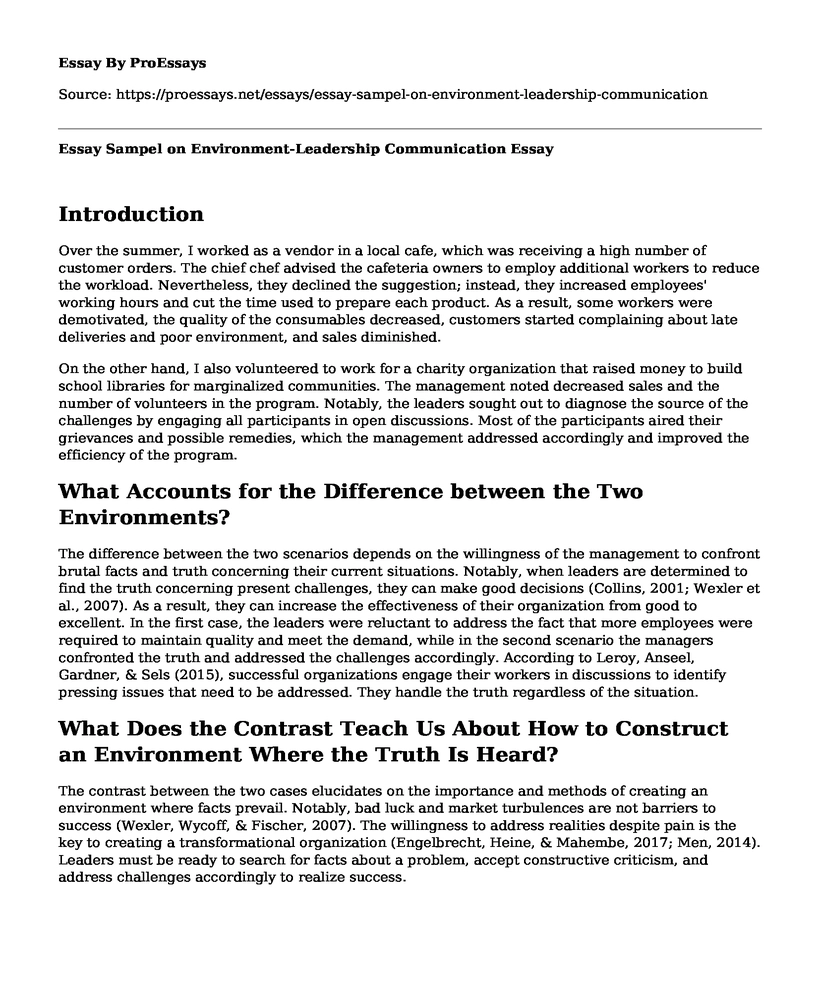Introduction
Over the summer, I worked as a vendor in a local cafe, which was receiving a high number of customer orders. The chief chef advised the cafeteria owners to employ additional workers to reduce the workload. Nevertheless, they declined the suggestion; instead, they increased employees' working hours and cut the time used to prepare each product. As a result, some workers were demotivated, the quality of the consumables decreased, customers started complaining about late deliveries and poor environment, and sales diminished.
On the other hand, I also volunteered to work for a charity organization that raised money to build school libraries for marginalized communities. The management noted decreased sales and the number of volunteers in the program. Notably, the leaders sought out to diagnose the source of the challenges by engaging all participants in open discussions. Most of the participants aired their grievances and possible remedies, which the management addressed accordingly and improved the efficiency of the program.
What Accounts for the Difference between the Two Environments?
The difference between the two scenarios depends on the willingness of the management to confront brutal facts and truth concerning their current situations. Notably, when leaders are determined to find the truth concerning present challenges, they can make good decisions (Collins, 2001; Wexler et al., 2007). As a result, they can increase the effectiveness of their organization from good to excellent. In the first case, the leaders were reluctant to address the fact that more employees were required to maintain quality and meet the demand, while in the second scenario the managers confronted the truth and addressed the challenges accordingly. According to Leroy, Anseel, Gardner, & Sels (2015), successful organizations engage their workers in discussions to identify pressing issues that need to be addressed. They handle the truth regardless of the situation.
What Does the Contrast Teach Us About How to Construct an Environment Where the Truth Is Heard?
The contrast between the two cases elucidates on the importance and methods of creating an environment where facts prevail. Notably, bad luck and market turbulences are not barriers to success (Wexler, Wycoff, & Fischer, 2007). The willingness to address realities despite pain is the key to creating a transformational organization (Engelbrecht, Heine, & Mahembe, 2017; Men, 2014). Leaders must be ready to search for facts about a problem, accept constructive criticism, and address challenges accordingly to realize success.
Using Strong Biblical Support, Explain How You Relate This to Your Christian Worldview?
In Christianity, the Bible emphasizes the importance of truth and honesty in an individual's life. People who seek the truth and are honest are liberated from their troubles. Jesus encouraged his disciples to know the truth since it would set them free (John 8:31-32). Additionally, Christian values advocate for Christians to stand by the truth and have faith in God as they confront evil and challenges in their lives (Ephesians 6: 13-17).
Does Your Christian Worldview Help You Develop This Environment?
My Christian worldview allows me to create an honest working environment. In this case, I am accountable for my deeds despite the consequences. Moreover, I tell the truth without fear of any criticism to facilitate accountability and responsibility. I also avoid engaging in unethical behavior since they are against Christian values.
How Does This Relate to the Ethical Components of the Meese and Ortmeier Text?
The bible passages relate to Meese and Ortmeier's ethical components text in such a way that it encourages honesty and accountability. According to Ortmeier & Meese (2010), police subcultures are obstacles to officers' responsibility since they engage in crime cover-ups, which is unethical. In this case, police officers protect their rogue counterparts from facing the law when they engage in immoral activities. In a Christian worldview, police officers should be honest and expose their scoundrel counterparts to facilitate better service delivery.
References
Collins, J. C. (2001). Good to Great: Why Some Companies Make the Leap and others Don't. Scotland: William Collins.
Hermosilla, D., Amutio, A., Da Costa, S., & Paez, D. (2016). Transformational leadership in organizations; Mediating variables and long-term consequences. Revista de Psicologia del Trabajo y de las Organizaciones, 32(3), 135-143. https://doi.org/10.1016/j.rpto.2016.06.003
Leroy, H., Anseel, F., Gardner, W. L., & Sels, L. (2015). Authentic leadership, authentic followership, basic need satisfaction, and work role performance: A cross-level study. Journal of Management, 41(6), 1677-1697. https://doi.org/10.1177/0149206312457822
Men, L. R. (2014). Strategic internal communication: Transformational leadership, communication channels, and employee satisfaction. Management Communication Quarterly, 28(2), 264-284. https://doi.org/10.1177/0893318914524536
Ortmeier, P. J., & Meese, E. (2010). Leadership, ethics, and policing: Challenges for the 21st century. London: Prentice Hall.
Wexler, C., Wycoff, M. A., & Fischer, C. (2007). "Good to Great" Policing: Application of Business Management Principles in the Public Sector. Washington, DC: Police Executive Research Forum.
Cite this page
Essay Sampel on Environment-Leadership Communication. (2022, Dec 13). Retrieved from https://proessays.net/essays/essay-sampel-on-environment-leadership-communication
If you are the original author of this essay and no longer wish to have it published on the ProEssays website, please click below to request its removal:
- Business Ethics and Corporate Social Responsibility in Apple
- Management Decision Problem for Increasing Share of the Athletic Shoe Market
- Global Business Issues in Decision Making Essay Example
- The Phase of Change by Michael Fullan Essay Example
- Essay Sample on Managing Organizational Culture
- Sustainable Development: Protecting Earth and Future Generations - Research Paper
- Essay Example on TechFite: Securing Growing Business With Real-Time Log Files







